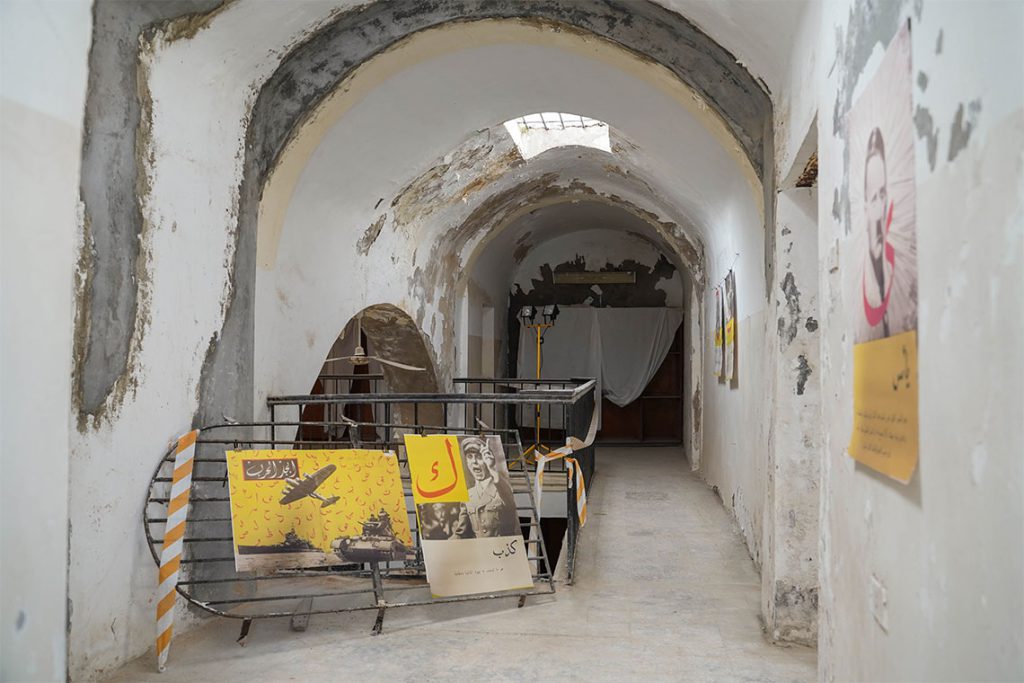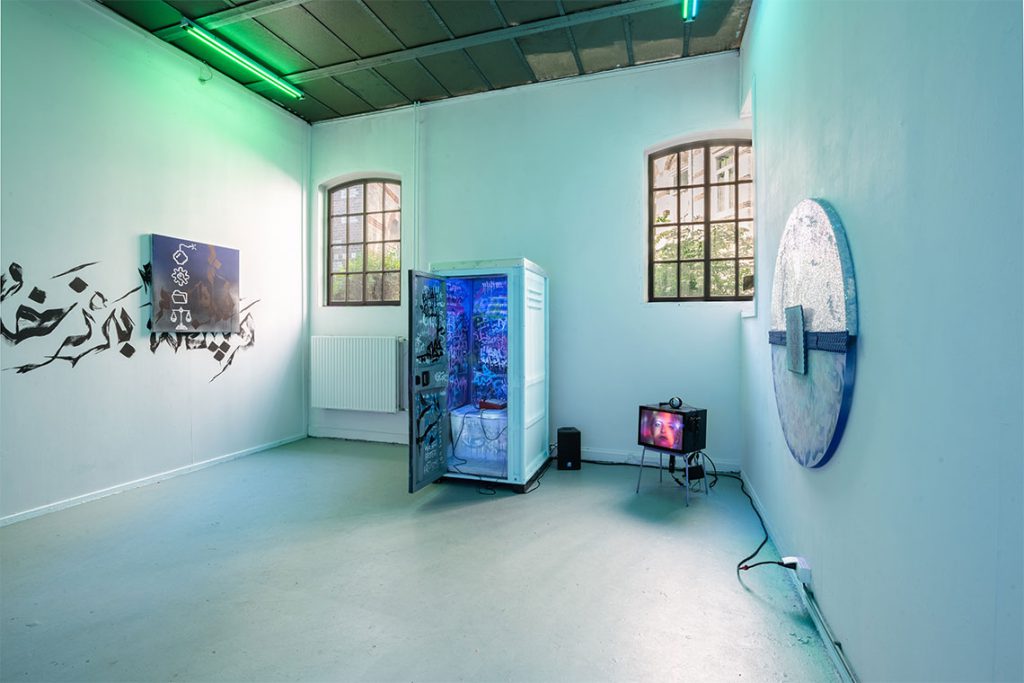The Amsterdam-based Libyan artist Takwa Barnosa – who goes by the name Tewa in reference to the Tamazight word for prayer or connection – works to unpack Libya’s socio-political and historical realities.
Canvas: Why are you an artist?
Tewa Baronsa: The turning point was the revolution in 2011, when I was 14 or so. Our lives changed radically, with governments falling, mass movements emerging. I started looking for ways to transmute certain emotions and the happenings around us. That was the point when I began to spend time exploring art in a more active manner.
How much exposure to art did you have before then?
I don’t come from an artistic family and the school system did not include arts or music. I was lucky because my mother encouraged us to be active learners. She’s an educator, so she was always saying “Look at this” or “There’s this course/workshop/reading”. She also has beautiful handwriting and taught Arabic calligraphy skills to my sisters and I, which later became part of my practice. I try to gather all these childhood obsessions and curiosities – calligraphy, poetry, rituals, preservation and documentation. It all started at that age and with the intellectual support of my mother.

Your work does not shy away from challenging themes. What drives you forward?
My own experiential reality of Libya. I cannot look away from it or the historical transformations that I have witnessed personally. The 1970s saw the advent of was what was called the “Cultural Revolution”, one of Muammar Gaddafi’s big campaigns of anti-imperialist propaganda. It succeeded in ruining any opportunities for cultural production and caused the erasure of the indigenous and generational knowledge that passes down through different media. Music was banned, except for what worked for the regime’s propaganda, and there were also numerous limitations on spaces, galleries and individuals who were pursuing artistic endeavours, literature or music. Many people were exiled and the isolation and sanctioning of Libya continued for years afterwards. I lived in a society that was the product of that era, which resulted in my exploration of politics, society, history and, by 2015, art making. To look away and make apolitical and abstracted work did not correspond to the reality that people were living, and on both personal and artistic levels there was this urgency to create infrastructures, open up conversations and examine histories. There were archives that systematically disappeared or were inaccessible, and a huge lack of cultural communication. It was a shared struggle with the Maghreb in general, as well as the wider Arab world and Africa. Some of the works that I’ve made in the last few years – such as Written to not remain and Teneri Ara Assensu / The sahara is not a hotel – were instantaneous. It was a matter of, “I can’t let go of this”. There’s an urgency around it.
Some believe that art can instigate change. Can it?
Perhaps five years ago I would have said yes, but more and more I understand that it’s really a case of art weaving certain truths, both personal and collective, and it’s from there that the discussion begins. After the revolution in Libya, all the civil society movements and the cultural community initiatives were hijacked by NGOs and Western developmental agencies, so the word ‘change’ slowly lost its value. For me, art is more of a tool, a way of being, and a practice that can gather people. If things change from there, then perfect. But I don’t want to think of art in extractivist ways. It’s an ecosystem that can provide possibilities to reveal and reflect, rather than to instigate change directly.
In 2015 you started WaraQ, an art space that has since closed. What other initiatives or projects have you been involved in?
WaraQ was a very Libyan project. The country had no infrastructure, no critical discourse, no artistic and collective practice involvement. The situation was only getting worse on the ground, war after war, displacements, death. Libya was hardly ever in the news internationally, so there was this need to unpack the socio-political dilemmas by image making, working with people and digging into archives. How do we gather? How do we look at the past? How do we learn from it? I started by opening WaraQ, in Tripoli in 2015, and when it was forcibly shut down, I moved on to initiate projects in the public space. Some projects took place after I had left or were online. I would visit Libya and try to do something there, though. One project was Shifting Sands. We published an open call to gather academics, artists and activists, and from there we ran three months of mentorship. Each person worked on a project, some related to the social and urban environments of Tripoli and Benghazi, some to colonial history, others about the civil war, identity and indigenous societies in Libya. I took more the role of mediator, initiator or facilitator, but it influenced my artistic practice. We were feeding one another. There is still so much work to do.

How would you characterise the art community in Libya right now?
There’s definitely a deep sense of fear in general, not just for artists. I go back every year. Recently, I’m seeing more art activity taking place, at least in Tripoli, and people are helping each other. It’s a small community of different generations that are slowly coming together. But there are still layers of isolation from the world, and the political and social damage doesn’t allow for dedicated and critical conversations, new ways of seeing, listening and shifting perspectives. There is always push back – Libyan society is indeed traumatised and the first response is almost always “no” – but I’ve realised that doesn’t make things impossible! It just takes time and sustained work. I can pursue art as my practice and profession to navigate issues in our society as long as the people who are physically in the community are always there to help, to talk with and show support.
You relocated to Europe in 2019 to pursue residencies. How has being in Berlin and Amsterdam, and soon The Hague, affected your practice?
It has evolved in more interdisciplinary ways. I’m working with different media and thinking of how to explore topics in ways that make sense of our surroundings. I’m now focusing on sound and sonic practices and including those in my projects. I was in Libya two weeks ago and realised that sound might be less provocative than the image, given the current lack of security in Tripoli. There’s an interesting learning curve. I’m seeing how my local context becomes entangled or intersects with how I pursue my work here diasporically. Doing things in Libya versus Europe involves completely different processes, challenges and rewards. My work has taken on more of a research approach, again with a focus on the act of revealing. When I’m working in Europe there is less desire to think about the social and collective value of what I do in terms of gathering people and making it a space of encounter, because there’s a different audience here, one that doesn’t relate to the same set of concerns. I always assume there’s ignorance and lack of information and perspective about Libya, so I think of how my work can play within these margins.
So is working in Europe more liberating or more challenging?
Both, in different ways. Working in Libya had its challenges and serious threats, yet it was rewarding and extremely liberating as there were multiple aspects of resilience throughout the various processes. While working in Europe, there’s a collective social value that is missing. It’s made me rethink my position as an artist. Instead of working on projects grounded in social engagement, such as Shifting Sands or earlier projects in the public spaces of the old city in Tripoli, in Europe I have space to work more critically on politics that I cannot engage with in Libya. The situation in Europe is also changing – there’s now so much censorship, racism and systematic discrimination alongside the fetishisation of our struggles in hyper-intellectualised settings such as institutions. Therefore, as an artist working in this continent, I know I am a full-time infiltrator. My practice is also attempting to understand the involvement of the West in Libya, how our lives are impacted by Western complicity and how things have shifted. Take my sound installation Teneri Ara Assensu as an example. It translates to ‘the Sahara is not a hotel’ and investigates the presence of unannounced French soldiers in Libya during the war, and parallel to that, the involvement of multiple local militias in mass killings, which are still ongoing. It was first shown in an exhibition entitled Hotel Sahara.
Which particular issues is your current work looking at?
The project I’m working on now – In yesterday’s forecasts, We predict grace – is an installation and a performance exploring topics around land, water and weather paranoia, following the floods that happened in Derna in eastern Libya in 2023. I’m thinking about political structures and their role in the ecological collapse, which is very much felt, and the relation to contemporary warfare in Libya and in Africa in general. I am weaving these narratives through poetry, image and sound, using radio wave and satellite experiments. All of this is manifested through the practice of the raha, an ancient ritual centred around a grinding millstone that women used to work with to process crops from their land. In Libya, it created a subgenre of oral literature, as the women sat together grinding seeds and reciting chants and humming. Somewhere between being celebratory and a lament, these rhythms are called abu tawil in Arabic and leghna azegrar in Tamazight. In my ongoing work, the raha becomes the body of resonance and the medium.
This interview first appeared in Canvas 117: The Maghreb Issue



